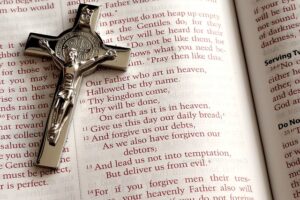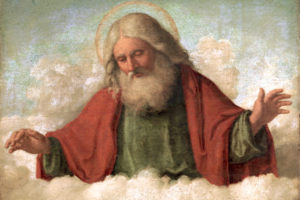The Bible’s Answer
In the first five days of the biblical account of creation, God created the heavens and the Earth, and filled our planet with animals and vegetation. After the fifth day, God looked down on his creation and “saw that it was good” (Gen 1:25, ESVUK). On the sixth and final day of creation, God created human beings as the pinnacle of his creation, because unlike any other creature on Earth, God created human beings in his image and likeness. After seeing his creation with human beings in it, God saw that it was not just good, but “very good” (Gen 1:31). Genesis 1:26–27 declares:
26 Then God said, ‘Let us make humankind in our image, according to our likeness; and let them have dominion over the fish of the sea, and over the birds of the air, and over the cattle, and over all the wild animals of the earth, and over every creeping thing that creeps upon the earth.’ 27 So God created humankind in his image, in the image of God he created them; male and female he created them. (Genesis 1:26–27, NRSV)
There have been many discussions by theologians on what exactly it means that humans are created in God’s image and likeness. What it ultimately comes down to, though, is the following main points.
- God has given humanity higher value than any other creation.
- God has made humanity like himself.
- God has created humanity to be his representatives on Earth.
- God has created humanity to have everlasting fellowship with him.
In the next few sections, we will explain in more detail each of these meanings, and look at their Scriptural foundations.
God Gave Human Life the Highest Value
The Bible itself doesn’t give us an exact definition of what the image and likeness of God in humanity is. It does, however, tell us about the implications of humanity being created this way. Dr Martin Luther, in his Lectures on Genesis 1–5, observes that God created nature and the animals without any deliberation or counsel (“Let the earth produce,” etc.), but with humanity, God said, “Let us make man in our image, after our likeness” (Gen 1:26, ESVUK, emphasis added).[1] He comments:
But here, when He wants to create man, God summons Himself to a council and announces some sort of deliberation … This indicates that man is a creature far superior to the rest of the living beings that live a physical life, especially since as yet his nature had not become depraved. (Luther’s Works Volume 1, 56)
As for how God could summon himself to a counsel, Luther says that the phrase “Let us make,” “is aimed at making sure the mystery of our faith, by which we believe that from eternity there is one God and that there are three separate Persons in one Godhead: the Father, the Son, and the Holy Spirit.”[2] In other words, God can logically speak in the first-person plural because he is a Holy Trinity, as revealed in later biblical passages (e.g. Mt 28:19; Jn 17:3; 20:28–29; Ac 5:3–4).
From the very beginning, God has always treated human life much higher than plant and animal life. We see this in the fact that after the worldwide flood of Genesis 8, God gave Noah, his family, and the rest of humanity the permission to not only eat plants, but also animals. We read:
2 The fear of you and the dread of you shall be upon every beast of the earth and upon every bird of the heavens, upon everything that creeps on the ground and all the fish of the sea. Into your hand they are delivered. 3 Every moving thing that lives shall be food for you. And as I gave you the green plants, I give you everything. (Genesis 9:2–3, ESVUK)
God’s desire for humanity to rule over the animal kingdom is proof of his gracious election of humans as possessing the greatest intrinsic value over all creatures. The Lord Jesus says as much, when teaching that while God cares for little sparrows, despite their apparent insignificance, humans “are of more value than many sparrows”, and that God has even numbered all the hairs of our heads (Lk 12:7). Furthermore, right after giving humanity the permission to kill animals for nourishment, God then establishes the death penalty for anyone or anything that kills humans (whether the culprit be a human or animal), on the basis that humans are made in God’s image:
5 And for your lifeblood I will require a reckoning: from every beast I will require it and from man. From his fellow man I will require a reckoning for the life of man. 6 “Whoever sheds the blood of man, by man shall his blood be shed, for God made man in his own image. (Genesis 9:5–6)
Not only does humanity being created in God’s image and likeness function as the basis for the protection of every human life, but it also functions as the basis for why all humans deserve to be treated with respect and dignity. St James teaches this, when teaching on the need for taming our tongues:
9 With [the tongue] we bless our Lord and Father, and with it we curse people who are made in the likeness of God. 10 From the same mouth come blessing and cursing. My brothers, these things ought not to be so. (James 3:9–10)
King David’s prayerful contemplation of God’s loving care towards humanity prompted him to write Psalm 8. In it, David compares the vastness and beauty of the galaxies above to the smallness and insignificance of a single human, which prompts him to ask, “what is man that you are mindful of him, and the son of man that you care for him?” (Ps 8:3–4). David goes on to say:
5 Yet you have made him a little lower than the heavenly beings and crowned him with glory and honour. 6 You have given him dominion over the works of your hands; you have put all things under his feet, 7 all sheep and oxen, and also the beasts of the field, 8 the birds of the heavens, and the fish of the sea, whatever passes along the paths of the seas. (Psalm 8:5–8)
Unlike the animals, God has crowned humanity with glory and honour, and even though humans are “a little lower than the heavenly beings”, that is, the angels, this is only a temporary thing, because one day Christians will judge the angels (1Cor 6:3). Furthermore, although both humanity and some angels fell into sin, Jesus did not come to Earth to help the fallen angels, but rather all of fallen humanity (Heb 2:16–17). God shows a special interest in and love for humans that is unparalleled to any other creature, because in order to save humanity from sin, God not only became a true human just like us, but he even gave up his life to ransom us from our sins by his blood. This took place when the Second Person of the Holy Trinity, Jesus Christ, who was born of the Virgin Mary (Jn 1:1–14), was crucified on a Roman cross, where he bore all our sins (1Pt 2:24), died, and rose again from the dead on the third day (Php 2:5–8). The Lord Jesus said, referring to himself as the Son of Man and of God:
14 And as Moses lifted up the serpent in the wilderness, so must the Son of Man be lifted up, 15 that whoever believes in him may have eternal life. 16 “For God so loved the world, that he gave his only Son, that whoever believes in him should not perish but have eternal life. (John 3:14–16)
God went to such self-sacrificial lengths to save humanity from sin’s consequences because we alone are created in his image and likeness.
God Created Humans Like Himself
Now that we have discussed the implications of humans possessing the image and likeness of God, we can move on to discuss what exactly this image and likeness consists of. In Dr Luther’s Lectures on Genesis 1–5, he affirms St Augustine and the other Church Doctors’ understanding of the image of God in us being the powers of the soul, that is: the memory, the mind or intellect, and the will, a Trinitarian constitution which reflects God’s own Trinitarian nature.[3] To this, though, Luther correctly adds that these have become severely damaged after Adam and Eve’s fall into sin.[4] He also affirms the Doctors’ understanding that the likeness or similitude of God in us refers to the perfection of that image through grace, namely, that “the intellect is enlightened by faith, the memory is made confident through hope and steadfastness, and the will is adorned with love.” Dr Steinmann also affirms that the image of God consists of superior human abilities and the power of reason.[5]
All this is to say, in summary, that God has made humans like himself—not physically, but spiritually. God is light (1Jn 1:5) and love (1Jn 4:8, 16), and because humans are created in his image and likeness, we are able to reflect God’s light and love in the world by our words and deeds (Mt 5:14–16; Jn 13:34–35; 1Jn 3:23). The Lord Jesus said:
I am the light of the world. Whoever follows me will not walk in darkness, but will have the light of life. (John 8:12)
The key emphasis here is that humans in and of themselves do not possess light, but rather we derive our light from the True Light, who is Jesus, by following him. We are only created in the image and likeness of God, but we are not the image of God or the exact representation of his being. Only one person fits the latter description, and that is Jesus, the God-man, who is “the brightness of [God’s] glory and the express image of His person” (Heb 1:3, NKJV). Consequently, when we choose not to follow Jesus and walk our own way instead, we exhibit the darkness of our sins.
In regards to humans possessing a will, this can be seen in the fact that God gave Adam and Eve alone the commandment to not eat from the tree of the knowledge of good and evil (Gen 2:16–17), indicating that they not only had the capacity to comprehend morality, but also the choice of whether or not to obey God, which is the function of the human will. Since the Fall, our will has been so damaged that we cannot choose to love God, unless the Holy Spirit first converts us to the Faith (Rom 8:5–9; 1Cor 12:3) through the Word of God, as it is spoken or written (the Bible) (1Thes 1:4–5; 2:13; 2Tim 3:14–16). On a similar note, the Epitome of the Formula of Concord says: “Even our first parents before the fall did not live without the Law. They had God’s Law written into their hearts, because they were created in God’s image (Genesis 1:26–27; 2:16–17; 3:3)” (FC Ep VI 2).[6] The Law of God in our hearts is our conscience—the moral compass inside each person which compels us to do good and gives us contrition when we do evil (Rm 2:14–16). Furthermore, the Bible says:
Also, [God] has put eternity into man’s heart, yet so that he cannot find out what God has done from the beginning to the end. (Ecclesiastes 3:11, ESVUK)
Because we have eternity in our hearts, we are able to ponder and seek for things that transcend this world, such as truth, beauty, life after death, as well as the existence of an almighty Creator. This affirms that humans possess an intellect and memory far unlike that of the animals. The fourth-century bishop, St Gregory of Nyssa, in The Great Catechism, summarises the image of God as being all that characterises God, in the following words:
Since, then, one of the excellences connected with the Divine nature is also eternal existence, it was altogether needful that the equipment of our nature should not be without the further gift of this attribute, but should have in itself the immortal, that by its inherent faculty it might both recognize what is above it, and be possessed with a desire for the divine and eternal life. In truth this has been shown in the comprehensive utterance of one expression, in the description of the cosmogony, where it is said that man was made “in the image of God”. For in this likeness, implied in the word image, there is a summary of all things that characterize Deity; and whatever else Moses relates, in a style more in the way of history, of these matters, placing doctrines before us in the form of a story, is connected with the same instruction.” (The Great Catechism, Chapter V)[7]
Indeed, to be created in God’s image and likeness simply means that God created us to live forever, to know him, and to desire the divine and eternal life that God himself lives. Finally, God’s image and likeness in us includes the perfection that Adam and Eve possessed in Paradise, which was lost after the Fall. Just as God himself is perfect in every way, both in his goodness and functional attributes (Deut 32:4; Jer 32:17; Mk 10:27; 1Jn 1:5), so too was everything about Adam and Eve perfect—their bodies functioned without flaw, their minds were sharp, and their hearts truly pure. We know that Adam and Eve were perfect because prior to their sin, there was no sin, death, or decay in the world (Rm 5:12–14; 8:19–23), and because only those who are innocent, holy, and blameless can dwell in the Holy God’s presence (Is 6:1–7; Rev 21:27). After discussing Adam and Eve’s perfection in Paradise, Luther sums up the image of God in the following words: “Therefore that image of God was something most excellent, in which were included eternal life, everlasting freedom from fear, and everything that is good.”[8]
God Created Humans Like Himself So That We May Represent Him
Dr Gordan J. Wenham, in the Eerdmans Commentary on the Bible, says that in the ancient world, it was widely believed that kings were in the image of God, in the sense that they were the god’s representative and governed the Earth on his behalf.[9] He continues on to say: “Though Genesis does not define what constitutes the image of God in man, it implies that it is those human characteristics that enable him to fulfill his duty of ruling the earth and filling it with his own kind.” Because humans are more like God than any other creature it was fitting that God chose humans to rule over creation, as opposed to any other creature.
Both before and after God created humankind in his image and likeness, God issued forth the plan and command for humans to have dominion over all creatures of the Earth, which indicates that the image of God is, indeed, linked with God’s desire for humanity to act as his earthly representatives. Genesis 1:28 declares:
28 And God blessed them. And God said to them, “Be fruitful and multiply and fill the earth and subdue it and have dominion over the fish of the sea and over the birds of the heavens and over every living thing that moves on the earth.” (Genesis 1:28)
This passage indicates that being created in God’s image and likeness is connected with participating in God’s works, because just as God rules over all the Earth as Lord (Ps 97:5), so too does God want humans to rule over all the Earth in his stead. The fact that we are God’s representatives means that we ought to rule over the Earth in love, for just as justice and righteousness are the foundation of God’s throne (Ps 97:2), so too are humans to practise justice and righteousness (Deut 16:20; Ps 11:7). Part of this involves being responsible stewards who care for God’s creation, as Genesis 2:15 makes clear:
The LORD God took the man and put him in the garden of Eden to work it and keep it. (Genesis 2:15)
Just as Adam worked in the Garden of Eden to preserve it, so too are humans today to take care of the animals and environment around us. There is no indication whatsoever in Scripture which suggests that humans can mistreat animals or the environment on the basis that we are above them; in fact, this is outright condemned by the Bible (Pr 12:10). Furthermore, in the same way that God is the Creator of all things (Gen 1:1), God also commands all humans (who do not have the spiritual gift of celibacy) to be co-creators with him, by getting married, and giving birth to children, who are also made in God’s image and likeness (Gen 2:24; 5:1–3; Mal 2:15).
God Created Humans Like Himself So That We May Have a Relationship with Him
Original Righteousness
Dr Philip Melanchthon, in the Apology of the Augsburg Confession, says that the image and likeness of God entails the original righteousness that Adam and Eve possessed in the Garden of Eden.[10] Commenting on this, he writes:
What else was this image and likeness other than that man was created with wisdom and righteousness so that he could apprehend God and reflect God? Mankind was given the gift of knowing God, fearing God, and being confident in God. This is how Irenaeus and Ambrose interpret the likeness of God. Ambrose not only says many things to this effect, but especially declares, “That soul is not, therefore, in the image of God, in which God is not [dwelling] at all times.” Paul shows in Ephesians 5:9 and Colossians 3:10 that the image of God is the knowledge of God, righteousness, and truth. Lombard is not afraid to say that original righteousness “is the very likeness to God which God implanted in man.” (Apology of the Augsburg Confession II (I) 18–21)
In like manner, the Heidelberg Catechism states: “God created [people] good and in his own image, that is, in true righteousness and holiness, so that they might truly know God their creator, love him with all their heart, and live with God in eternal happiness, to praise and glorify him” (HC Q.6).[11] Right after God created Adam and Eve in his image and likeness, he gave them the commandments to rule over the animals (Gen 1:28) and work in the Garden (Gen 2:15), which they followed faithfully, implying that the image of God is connected with having harmonious fellowship with God.
In the beginning, God had planned for Adam, Eve, and all their children to have everlasting, perfect fellowship with him in Paradise. The original righteousness of humanity was that which allowed Adam and Eve to dwell directly with God in the Garden of Eden, where God walked among them without hiding his presence (Gen 3:8). But all this changed after Adam and Eve disobeyed God by eating the fruit of the tree of the knowledge of good and evil, thus wanting to put themselves in God’s place by deciding for themselves what was right and wrong (Gen 2:16–17; 3:1–7). After this, they were cast out from the Garden, lost fellowship with God (Gen 3:22–24), and sin and death entered creation (Rm 8:19–23). As a result of their rebellion, Adam and Eve lost their original righteousness and inherited the curse of original sin, which they passed on to all subsequent humans (Rm 5:12–14), in response to which God hid his presence from humanity in a cloud of fire from then on, and ceased dwelling with us directly, due to our sins (Ex 19:9, 18; 33:18–23).
The Human Soul
Furthermore, the image and likeness of God is linked with possessing a soul, because the moment God created Adam, he made him “a living soul”:
And the LORD God formed man of the dust of the ground, and breathed into his nostrils the breath of life; and man became a living soul. (Genesis 2:7, KJV)
The Catechism of the Catholic Church gives a good definition of the soul, in the following words: “In Sacred Scripture the term “soul” often refers to human life or the entire human person. But “soul” also refers to the innermost aspect of man, that which is of greatest value in him, that by which he is most especially in God’s image: “soul” signifies the spiritual principle in man” (CCC 363).[12] The Bible says that “God is spirit” (Jn 4:24, ESVUK), so because humans have both a body and soul—a physical and spiritual aspect to our being—we can know and love God. The fifth-century Christian theologian, St Augustine, affirmed this in The City of God, when discussing that according to Scripture, the body and soul make up the whole human:
For who is prohibited from saying, in colloquial usage,
That man is dead, and is now at rest or in torment,though this can be spoken only of the soul; orHe is buried in such and such a place,though this refers only to the body? Will they say that Scripture follows no such usage? On the contrary, it so thoroughly adopts it, that even while a man is alive, and body and soul are united, it calls each of them singly by the name “man,” speaking of the soul as the “inward man,” and of the body as the “outward man,” as if there were two men, though both together are indeed but one. But we must understand in what sense man is said to be in the image of God, and is yet dust, and to return to the dust. The former is spoken of the rational soul, which God by His breathing, or, to speak more appropriately, by His inspiration, conveyed to man, that is, to his body; but the latter refers to his body, which God formed of the dust, and to which a soul was given, that it might become a living body, that is, that man might become a living soul. (The City of God, Book XIII, Chapter 24)[13]
Thus, the image of God is not only related to our roles on Earth and our physical and mental capabilities, but more importantly also to the innermost part of our being, the spiritual component, which is of highest value. Jesus clearly taught a distinction between the human body and soul, and that the soul continues to live on after death, when he said:
And do not fear those who kill the body but cannot kill the soul. Rather fear him who can destroy both soul and body in hell. (Matthew 10:28)
Because God has created us with a soul, we alone can have fellowship with him, unlike any of the animals, who live in God’s world, but do not have the capacity to know or love him. In light of everything that has been discussed so far, when we pursue a relationship with God, when we live according to his commandments, and when we faithfully represent him and care for his creation, we are fulfilling what it truly means to be human. This is because at the heart of humanity lies the image and likeness of God. But when we reject or ignore God, when we don’t follow his commandments, and when we behave cruelly towards one another and the animals, we not only rebel against God, but also human nature, and behave more like beasts with no understanding than humans (Ps 32:9).
Jesus Christ Is the Image of God
When Adam and Eve sinned against God, they lost their original righteousness, and henceforth that aspect of the image of God has been destroyed in humanity. Paul confirms this in saying that there is not a single righteous person in the world (Rm 3:10–12) and that from Adam, sin and death spread to all humans (Rm 5:12–14). There is, however, one person who never committed a single sin, and that person is Jesus Christ, the righteous (Heb 4:15; 1Pt 2:22; 1Jn 2:1). Throughout his life, Jesus not only lived in perfect communion with his heavenly Father and the Holy Spirit (Jn 5:19–20; 8:29; 15:26; 16:13–15), but he is the very incarnation of God himself (Jn 1:1, 14), and thus the very embodiment of truth (Jn 14:6), righteousness, wisdom (1Cor 1:30), and eternal life (1Jn 1:1–4). Moreover, the Bible teaches that Jesus created humanity in the beginning, along with everything else in existence (Col 1:16–17). For these reasons, Scripture says that Jesus is not only in the image of God, but that he is the image of God:
[The Son] is the image of the invisible God, the firstborn of all creation. (Colossians 1:15)
In their case the god of this world has blinded the minds of the unbelievers, to keep them from seeing the light of the gospel of the glory of Christ, who is the image of God. (2 Corinthians 4:4)
Because Jesus lived a perfect life, he lived more like a human than any other human in existence, because in doing so he truly fulfilled what it means to be in the image of God. Although we have failed to live up to the image of God in us, the good news is that when we abide in Jesus by faith, the Holy Spirit conforms us back to the image of Jesus Christ, in whose image humanity was originally created:
For those whom [God] foreknew he also predestined to be conformed to the image of his Son, in order that he might be the firstborn among many brothers. (Romans 8:29)
45 Thus it is written, “The first man Adam became a living being”; the last Adam became a life-giving spirit. … 49 Just as we have borne the image of the man of dust, we shall also bear the image of the man of heaven. (1 Corinthians 15:45, 49)
And we all, with unveiled face, beholding the glory of the Lord, are being transformed into the same image from one degree of glory to another. For this comes from the Lord who is the Spirit. (2 Corinthians 3:18)
The work of Christ on the cross and in his resurrection reverses the effects of the Fall of Eden. When we put our faith in Jesus as our only Saviour, we have peace with God (Rm 5:1), and Jesus, who atoned for all our sins on the cross and intercedes for us (Heb 9:24–29), gives us full access to God the Father, by the Holy Spirit (Eph 2:18; Heb 10:19–22). Because of this, when a Christian dies, he or she will not be damned, but instead raised to everlasting life and fellowship with God in Heaven, from where we will await the resurrection of our bodies that will be like Jesus’ glorious resurrected body at his second coming (1Cor 15:20–23; 40–49). In Revelation, St John caught a glimpse of what this eternal fellowship looks like in the new Heaven and Earth, in which God will once again dwell directly with redeemed humanity forever—referring to all the saints who die having believed in Christ (Rev 22:3–4). Commenting on the restoration of God’s image in Christ, Dr Luther writes:
What we achieve in life, however, is brought about, not by the dominion which Adam had but through industry and skill. … Therefore we retain the name and word “dominion” as a bare title, but the substance itself has been almost entirely lost. Yet it is a good thing to know these facts and to ponder them, so that we may have a longing for that coming Day when that which we lost in Paradise through sin will be restored to us. We are waiting for that life for which Adam also should have waited. And we duly marvel at this and thank God for it, that although we are so disfigured by sin, so dull, ignorant, and dead, as it were, nevertheless, through the merit of Christ, we wait for the same glory of the spiritual life for which Adam would have waited if he had remained in his physical life, which was endowed with the image of God. (Luther’s Works Volume 1, 67–68)[14]
While the process of the Holy Spirit conforming Christians to Christ’s image will never be finished in this life on Earth, it will be finished the moment we die, or when Jesus returns in glory before then to judge the living and the dead (1Cor 15:50–52; 2Tim 4:1). On that day, we will finally live out our humanity fully with God in the way he originally intended, which will bring the redeemed in Christ everlasting satisfaction in their eternal home.
Conclusion
When the Bible says that God created humankind in his image and likeness, it means: that God gave humans higher value than any other creature; that God made humans like himself; that God created humans to represent him; and that God created humans to have eternal fellowship with him. More specifically, it means that God gave humans a mind, memory, and will like his, a conscience so that they can love good like him, a soul so that they can have fellowship with him, and that God originally made humanity righteous.
Although we lost that righteousness by sinning against God, he gave Christians the Holy Spirit through his spoken and written Word, who conforms them back to the image of Jesus Christ, our Creator and Redeemer, throughout our lives on Earth. This process will finally be complete when we arrive in our heavenly home. While God does love the animals and angels, he loves humans more than any other created being because we alone bear his image and likeness. Thanks be to God for his eternal love towards us.
Notes
[1] Martin Luther, Luther’s Works Volume 1: Lectures on Genesis Chapters 1–5, ed. Jaroslav Pelikan (Saint Louis: Concordia Publishing House, 1958), 56.
[2] Luther, Luther’s Works Volume 1, 57.
[3] Luther, Luther’s Works Volume 1, 60.
[4] Luther, Luther’s Works Volume 1, 62.
[5] Andrew E. Steinmann, Called To Be God’s People: An Introduction to the Old Testament (Eugene, Oregon: Wipf & Stock, 2006), 92.
[6] Paul Timothy McCain, Edward A. Engelbrecht, Robert C. Baker, and Gene Edward Veith, eds, Concordia: The Lutheran Confessions (Saint Louis: Concordia Publishing House, 2006), 486.
[7] Gregory Nyssen, “The Great Catechism,” in The Church Fathers. The Complete Ante-Nicene & Nicene and Post-Nicene Church Fathers Collection: 3 Series, 37 Volumes, 65 Authors, 1,000 Books, 18,000 Chapters, 16 Million Words, trans. William Moore, M.A., and Henry Austin Wilson, M.A., ed. Philip Schaff (London, England: Catholic Way Publishing, 2014), 27807, Kindle.
[8] Luther, Luther’s Works Volume 1, 65.
[9] Gordon J. Wenham, “Genesis,” in Eerdmans Commentary on the Bible, ed. James D. G. Dunn and John W. Rogerson (Grand Rapids, Michigan: William B. Eerdmans Publishing Company, 2003), 39.
[10] McCain et al., Concordia: The Lutheran Confessions, 78.
[11] Christian Reformed Church in North America and Reformed Church in America, Heidelberg Catechism (Grand Rapids, Michigan: Faith Alive Christian Resources, 2011), https://www.crcna.org/welcome/beliefs/confessions/heidelberg-catechism.
[12] Catholic Church, Catechism of the Catholic Church. 2nd ed. (Huntingdon, Pennsylvania: Our Sunday Visitor, 2000), https://www.vatican.va/archive/ENG0015/__P1B.HTM.
[13] Aurelius Augustinus, “The City of God,” in The Church Fathers. The Complete Ante-Nicene & Nicene and Post-Nicene Church Fathers Collection: 3 Series, 37 Volumes, 65 Authors, 1,000 Books, 18,000 Chapters, 16 Million Words, trans. Marcus Dods, D.D., ed. Philip Schaff (London, England: Catholic Way Publishing, 2014), 11829, Kindle.
[14] Luther, Luther’s Works Volume 1, 67–68.
Bibliography
Augustinus, Aurelius. “The City of God.” In The Church Fathers. The Complete Ante-Nicene & Nicene and Post-Nicene Church Fathers Collection: 3 Series, 37 Volumes, 65 Authors, 1,000 Books, 18,000 Chapters, 16 Million Words. Translated by Marcus Dods, D.D., edited by Philip Schaff. London, England: Catholic Way Publishing, 2014. Kindle.
Catholic Church. Catechism of the Catholic Church. 2nd ed. Huntingdon, Pennsylvania: Our Sunday Visitor, 2000. https://www.vatican.va/archive/ENG0015/_INDEX.HTM.
Christian Reformed Church in North America and Reformed Church in America. Heidelberg Catechism. Grand Rapids, Michigan: Faith Alive Christian Resources, 2011. https://www.crcna.org/welcome/beliefs/confessions/heidelberg-catechism.
Luther, Martin. Luther’s Works Volume 1: Lectures on Genesis Chapters 1–5. Edited by Jaroslav Pelikan. Saint Louis: Concordia Publishing House, 1958.
McCain, Paul Timothy, Edward A. Engelbrecht, Robert C. Baker, and Gene Edward Veith, eds. Concordia: The Lutheran Confessions. Saint Louis: Concordia Publishing House, 2006.
Nyssen, Gregory. “The Great Catechism.” In The Church Fathers. The Complete Ante-Nicene & Nicene and Post-Nicene Church Fathers Collection: 3 Series, 37 Volumes, 65 Authors, 1,000 Books, 18,000 Chapters, 16 Million Words. Translated by William Moore, M.A., and Henry Austin Wilson, M.A., edited by Philip Schaff. London, England: Catholic Way Publishing, 2014. Kindle
Steinmann, Andrew E. Called To Be God’s People: An Introduction to the Old Testament. Eugene, Oregon: Wipf & Stock, 2006.
Wenham, Gordon J. “Genesis.” In Eerdmans Commentary on the Bible, edited by James D. G. Dunn and John W. Rogerson, 32–71. Grand Rapids, Michigan: William B. Eerdmans Publishing Company, 2003.






